Boundary Layer Transition Prediction on Planar Turbine Cascade Using Temperature-Sensitive Paint and Numerical Simulation
Abstract
1. Introduction
2. Transitional Measurement Experiment on TSP
2.1. TSP Principle
2.2. Wind-Tunnel Test Device
2.3. Experimental Data Processing and Result Analysis
3. Numerical Prediction of Transition
3.1. Numerical Method and Validation
3.2. Numerical Results
3.2.1. Influence of Ma2
3.2.2. Influence of Attack Angle
3.2.3. Shock-Wave Influence
4. Conclusions
- (1)
- TSP transitional measurement results show that the transitional location was about 0.63 Lax at Ma2 = 0.4, Re1 = 3.1 × 105, and transition occurred at approximately 0.42 Lax at Ma2 = 1.03 Re1 = 8.6 × 105. As Re1 decreased, the transitional location moved backward, about 0.47 Lax at Ma2 = 1.03, Re1 = 3.1 × 105. The transitional location shifted backward with the increase in Ma2, occurring at about 0.49 Lax at Ma2 = 1.2, Re1 = 8.6 × 105.
- (2)
- The numerical calculations of the planar cascade with Ma2 < 1 (Ma2 = 0.56, 0.78, 0.98) and α (α = −10°, 0°, 10°) were completed. The boundary layer transition of the planar cascade moved forward with the increase in Ma2 and α.
- (3)
- Numerical calculations of the planar cascade with Ma2 > 1 (Ma2 = 1.1, 1.2, 1.4) were carried out. The transitional location of the boundary layer moved backward with the increase in Ma2, which was consistent with the experimental results. In addition, the generation of shock waves formed a large adverse pressure gradient that led to the onset of transition.
Author Contributions
Funding
Data Availability Statement
Acknowledgments
Conflicts of Interest
References
- Reshotko, E. Boundary-layer stability and transition. Annu. Rev. Fluid Mech. 1976, 8, 311–349. [Google Scholar] [CrossRef]
- Moin, P.; Mahesh, K. Direct numerical simulation: A tool in turbulence research. Annu. Rev. Fluid Mech. 1998, 30, 539–578. [Google Scholar] [CrossRef]
- Herbert, T. Secondary instability of boundary layers. Annu. Rev. Fluid Mech. 1988, 20, 487–526. [Google Scholar] [CrossRef]
- Coull, J.; Hodson, H. Unsteady turbines boundary-layer transition in low-pressure. J. Fluid Mech. 2011, 681, 370–410. [Google Scholar] [CrossRef]
- Zhong, X.; Wang, X. Direct numerical simulation on the receptivity, instability, and transition of hypersonic boundary layers. Annu. Rev. Fluid Mech. 2012, 44, 527–561. [Google Scholar] [CrossRef]
- Parziale, N.; Shepherd, J.; Hornung, H.G. Differential interferometric measurement of instability in a hypervelocity boundary layer. AIAA J. 2013, 51, 750–754. [Google Scholar] [CrossRef]
- Matsumura, S.; Schneider, S.; Berry, S. Flow Visualization Measurement Techniques for High-Speed Transition Research in the Boeing/AFOSR Mach-6 Quiet Tunnel. In Proceedings of the 39th AIAA/ASME/SAE/ASEE Joint Propulsion Conference and Exhibit, Huntsville, AL, USA, 20–23 July 2013. [Google Scholar]
- Kwak, D.Y.; Yoshida, K.; Noguchi, M.; Ishikawa, H. Boundary layer transition measurement using Preston tube on NEXST-1 flight test. In Proceedings of the 25th AIAA Applied Aerodynamics Conference, Miami, FL, USA, 25–28 June 2007. [Google Scholar]
- Drake, A. Oil film interferometry in the development of long endurance aircraft. In Proceedings of the 48th AIAA Aerospace Sciences Meeting Including the New Horizons Forum and Aerospace Exposition, Orlando, FL, USA, 4–7 January 2010. [Google Scholar]
- Hilfer, M.; Dufhaus, S.; Yorita, D.; Klein, C.; Petersen, A. Application of pressure- and temperature-sensitive paint on a highly loaded turbine guide vane in a transonic linear cascade. In Proceedings of the Global Power and Propulsion Society Forum, Zurich, Switzerland, 16–18 January 2017. [Google Scholar]
- Fey, U.; Egami, Y.; Konrath, R.; Kirmse, T.; Ahlefeldt, T.; Kompenhans, J. Advanced measurement techniques for high Reynolds number testing in cryogenic wind tunnels. In Proceedings of the 48th AIAA Aerospace Sciences Meeting Including the New Horizons Forum and Aerospace Exposition, Orlando, FL, USA, 4–7 January 2010. [Google Scholar]
- Hausmann, F.; Schroeder, W.; Limberg, W. Development of a multi-sensor hot-film measuring technique for transition detection in cruise flight. In Proceedings of the 40th AIAA Aerospace Sciences Meeting & Exhibit, Reno, NV, USA, 14–17 January 2002. [Google Scholar]
- Jun, Z.; Zhenghong, G.; Hao, Z.; Junqiang, B. A high-speed nature laminar flow airfoil and its experimental study in wind tunnel with nonintrusive measurement technique. Chin. J. Aeronaut. 2009, 22, 225–229. [Google Scholar] [CrossRef]
- Halstead, D.E.; Wisler, D.C.; Okiishi, T.H.; Walker, G.J.; Hodson, H.P.; Shin, H.W. Boundary Layer Development in Axial Compressors and Turbine: Part 1 of 4 Composite Picture. J. Turbomach. 1997, 119, 114–127. [Google Scholar] [CrossRef]
- Chen, Z.; Guo, Y.C.; Gao, C. Principle and technology of three-dimensional PIV. J. Exp. Fluid Mech. 2006, 20, 77–82, 105. (In Chinese) [Google Scholar]
- Medina, H.; Benard, E.; Huang, J.C.; Raghunathan, S. Study of the fluid mechanics of transitional steady and pulsed impinging jets using a high-speed PIV system. In Proceedings of the 46th AIAA Aerospace Sciences Meeting and Exhibit, Reno, NV, USA, 7–10 January 2008. [Google Scholar]
- Horstmann, K.; Redeker, G.; Quast, A.; Dressler, U.; Bieler, H. Flight Tests with a Natural Laminar Flow Glove on a Transport Aircraft. In Proceedings of the AIAA Flight Simulation Technologies Conference and Exhibit, Dayton, OH, USA, 17–19 September 1990. [Google Scholar]
- Horstmann, K.H.; Quast, A.; Redeker, G. Flight and wind-tunnel investigation on boundary layer transition at reynold number up to 10 to the 7th. In Proceedings of the 16th ICAS Congress, Jerusalem, Israel, 28 August–2 September 1988; Volume 2, pp. 979–986. [Google Scholar]
- Holmes, B.J.; Gall, P.D.; Croom, C.C.; Manuel, G.S.; Kelliher, W.C. A New Method for Laminar Boundary Layer Transition Visualization in Flight: Color Changes in Liquid Crystal Coatings: NASA-TM-87666[R]; NASA: Washington, DC, USA, 1986.
- Mee, D.J.; Walton, T.W.; Harrison, S.B.; Jones, T. A comparison of liquid crystal techniques for transition detection: AIAA-1991-0062[R]. In Proceedings of the 29th Aerospace Sciences Meeting, Reston, VA, USA, 7–10 January 1991. [Google Scholar]
- Kameda, M. Fast-responding pressure-sensitive paints for unsteady flow measurement. In Proceedings of the 10th Pacific Symposium on Flow Visualization and Image Processing, Naple, Italy, 15–18 June 2015. [Google Scholar]
- Gregory, J.W.; Sakaue, H.; Liu, T.; Sullivan, J.P. Fast pressure-sensitive paint for flow and acoustic diagnostics. Annu. Rev. Fluid Mech. 2014, 46, 303–330. [Google Scholar] [CrossRef]
- Zhu, Y.; Chen, X.; Wu, J.; Chen, S.; Lee, C.; Gad-el-Hak, M. Aerodynamic heating in transitional hypersonic boundary layers: Role of second-mode instability. Phys. Fluids 2018, 30, 011701. [Google Scholar] [CrossRef]
- Fey, U.; Egami, Y.; Engler, R. High Reynolds number transition detection by means of temperature sensitive paint. In Proceedings of the 44th AIAA Aerospace Sciences Meeting and Exhibit, Reno, NV, USA, 9–12 January 2006. [Google Scholar]
- Hampali, C.D. Numerical analysis of laminar to turbulent transition boundary layer flow. Mater. Today Proc. 2021, 54, 319–324. [Google Scholar]
- DiviaHarshaVardini, R.C.; Arul Prakash, K.; Rajesh, G. An all-speed formulation using a modified γ-model for the prediction of boundary layer transition and heat transfer. Int. J. Heat Mass Transf. 2022, 195, 123121. [Google Scholar]
- Liu, T.; Sullivan, J.P. Pressure and Temperature Sensitive Paints; Springer: Berlin/Heidelberg, Germany, 2005. [Google Scholar]
- Langtry, R.B. A Correlation-Based Transition Model Using Local Variables for Unstructured Parallelized CFD Codes. Master’s Thesis, University of Stuttgart, Stuttgart, Germany, 2006. [Google Scholar]
- Wang, W.; Tai, G.; Pei, J.; Pavesi, G.; Yuan, S. Numerical investigation of the effect of the closure law of wicket gates on the transient characteristics of pump-turbine in pump mode. Renew. Energy 2022, 194, 719–733. [Google Scholar] [CrossRef]
- Tomac, M.; Pettersson, K.; Rizzi, A. Calibration and Verification of a γ − Reθt Transition Prediction Method for Airfoil Computations. In Proceedings of the 51st AIAA Aerospace Sciences Meeting including the New Horizons Forum and Aerospace Exposition, Grapevine, TX, USA, 7–10 January 2013. [Google Scholar]
- Malan, P.; Suluksna, K.; Juntasaro, E. Calibrating the the Gamma-Re_theta Transition Model for Commercial CFD. In Proceedings of the 47th AIAA Aerospace Sciences Meeting including The New Horizons Forum and Aerospace Exposition, Orlando, FL, USA, 5–8 January 2009. [Google Scholar]

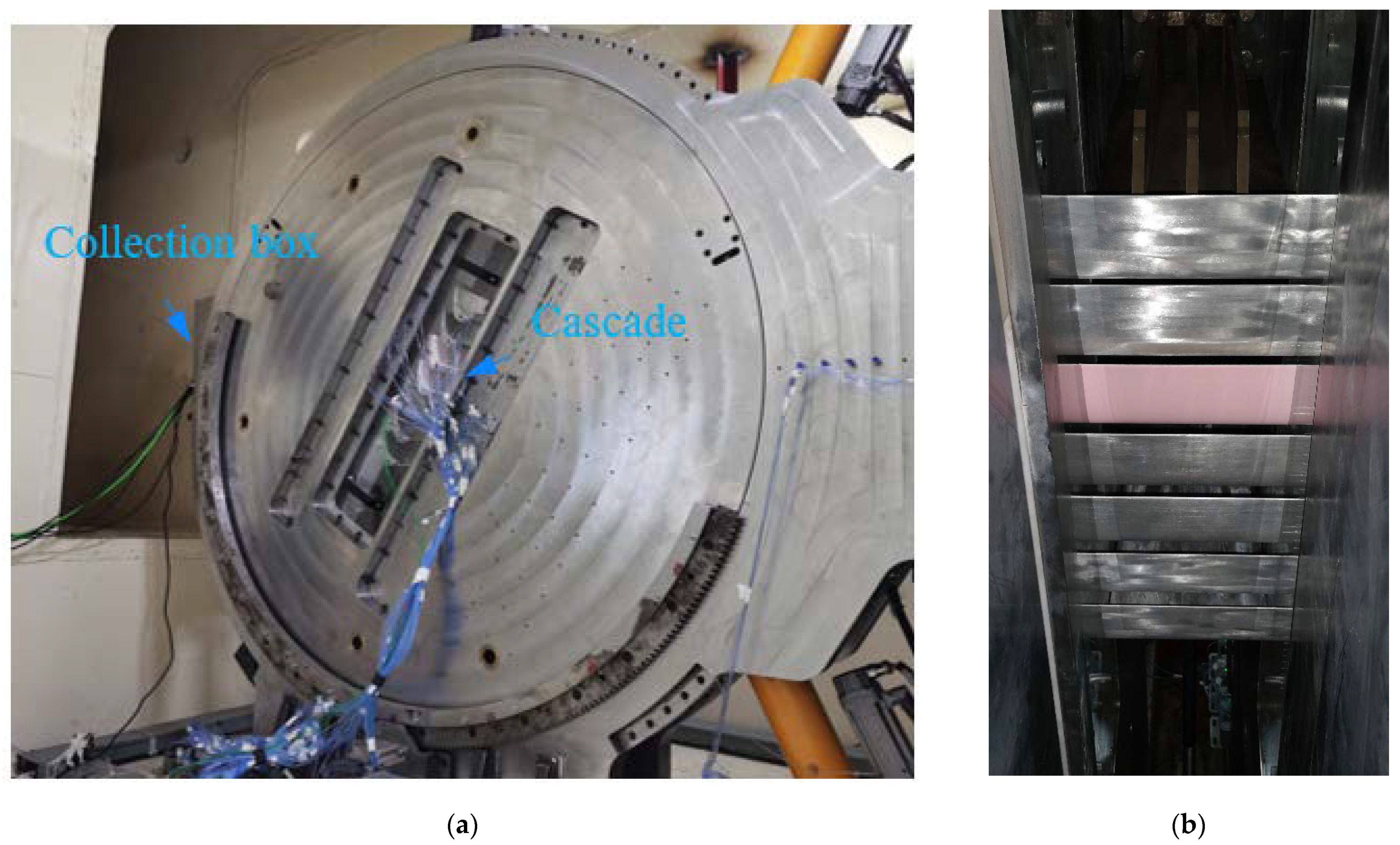
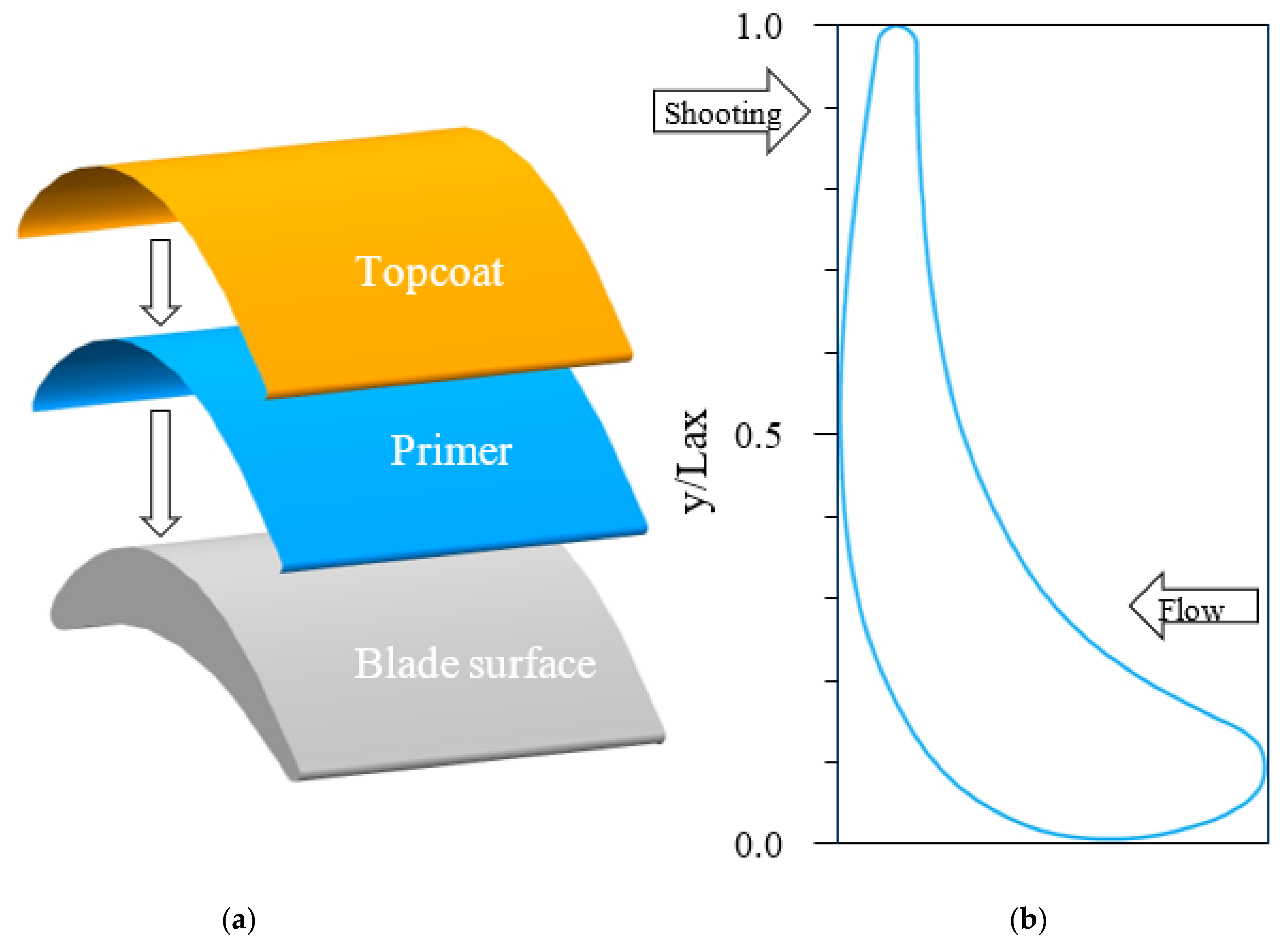
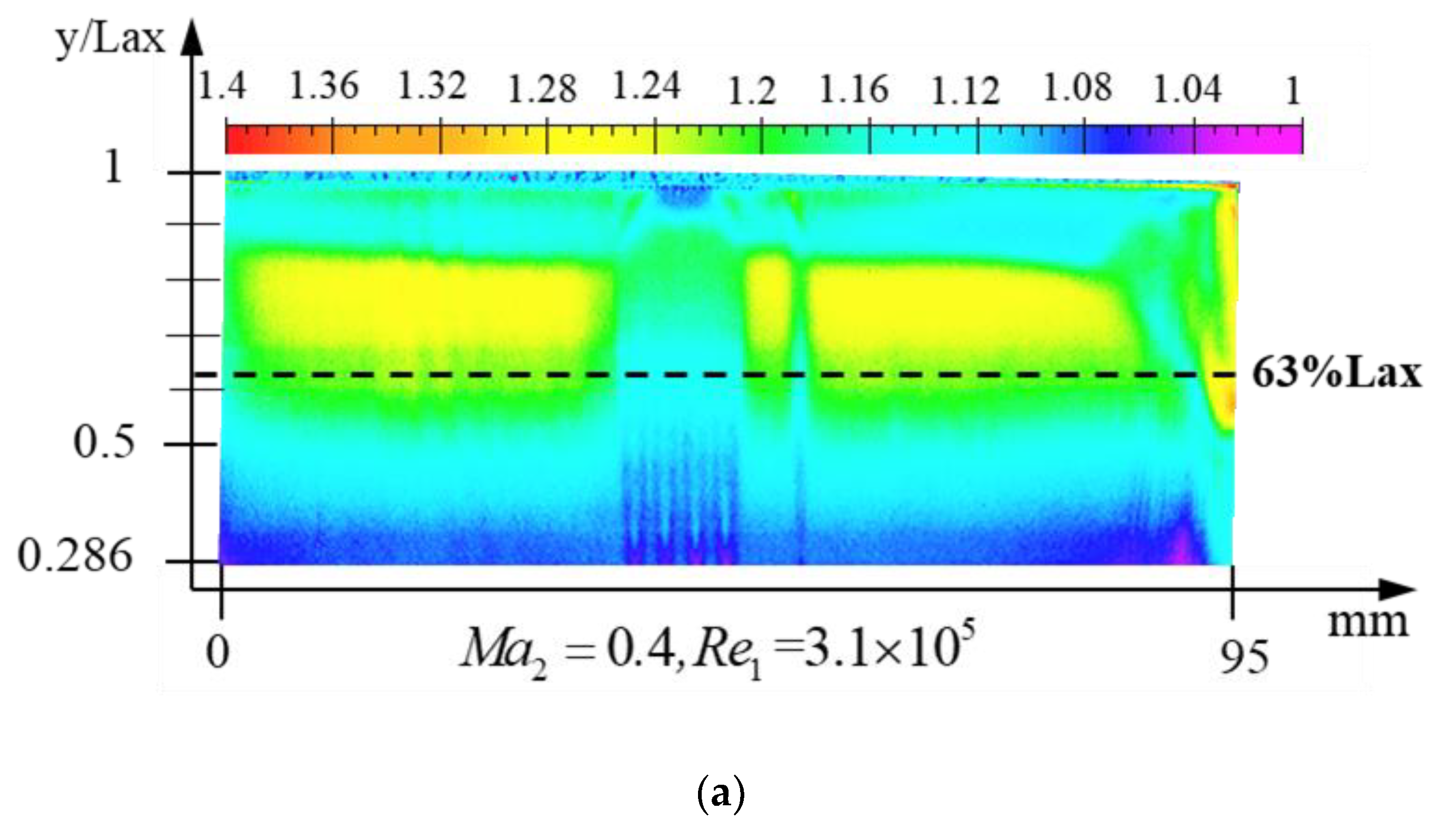







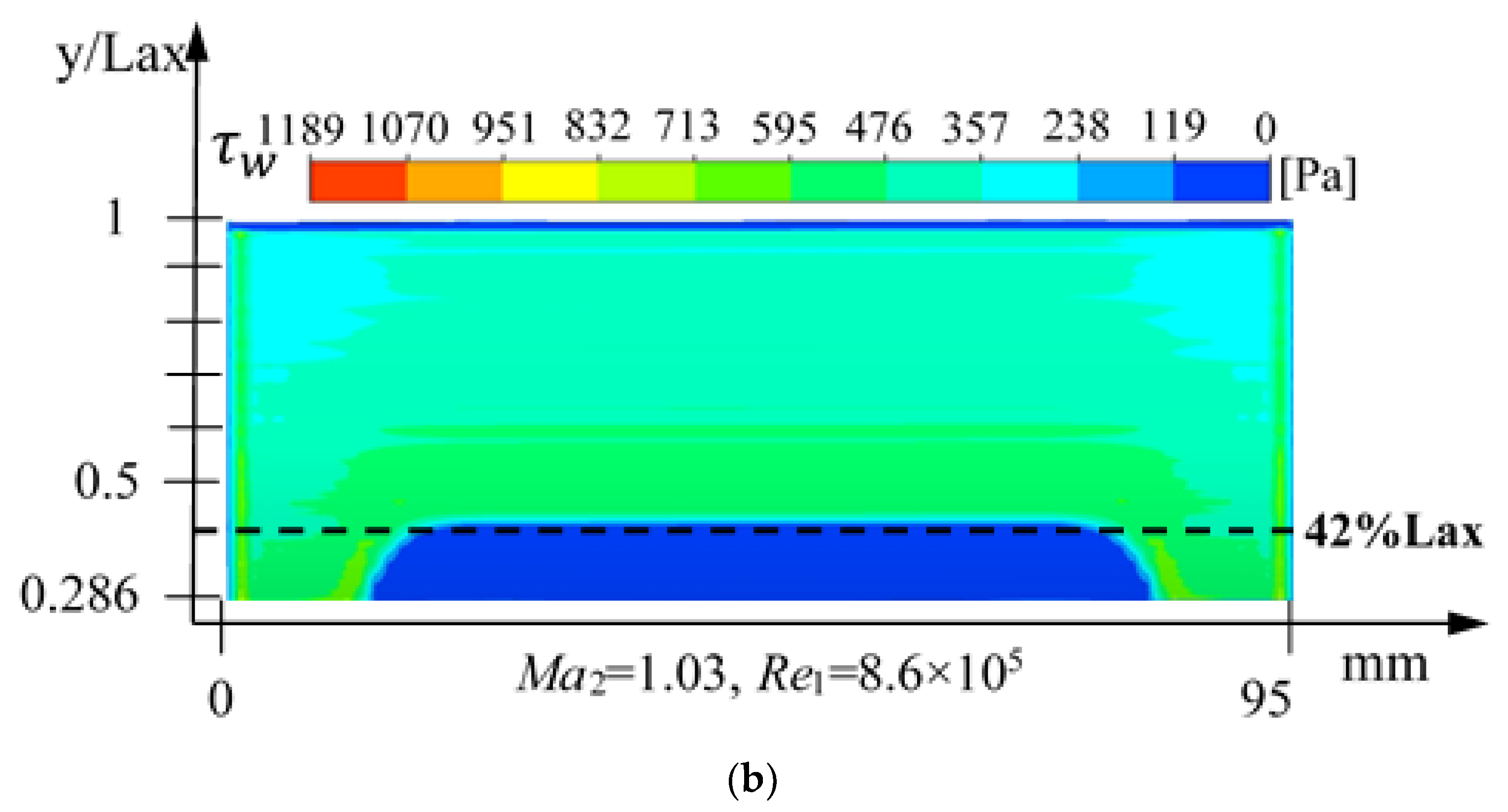

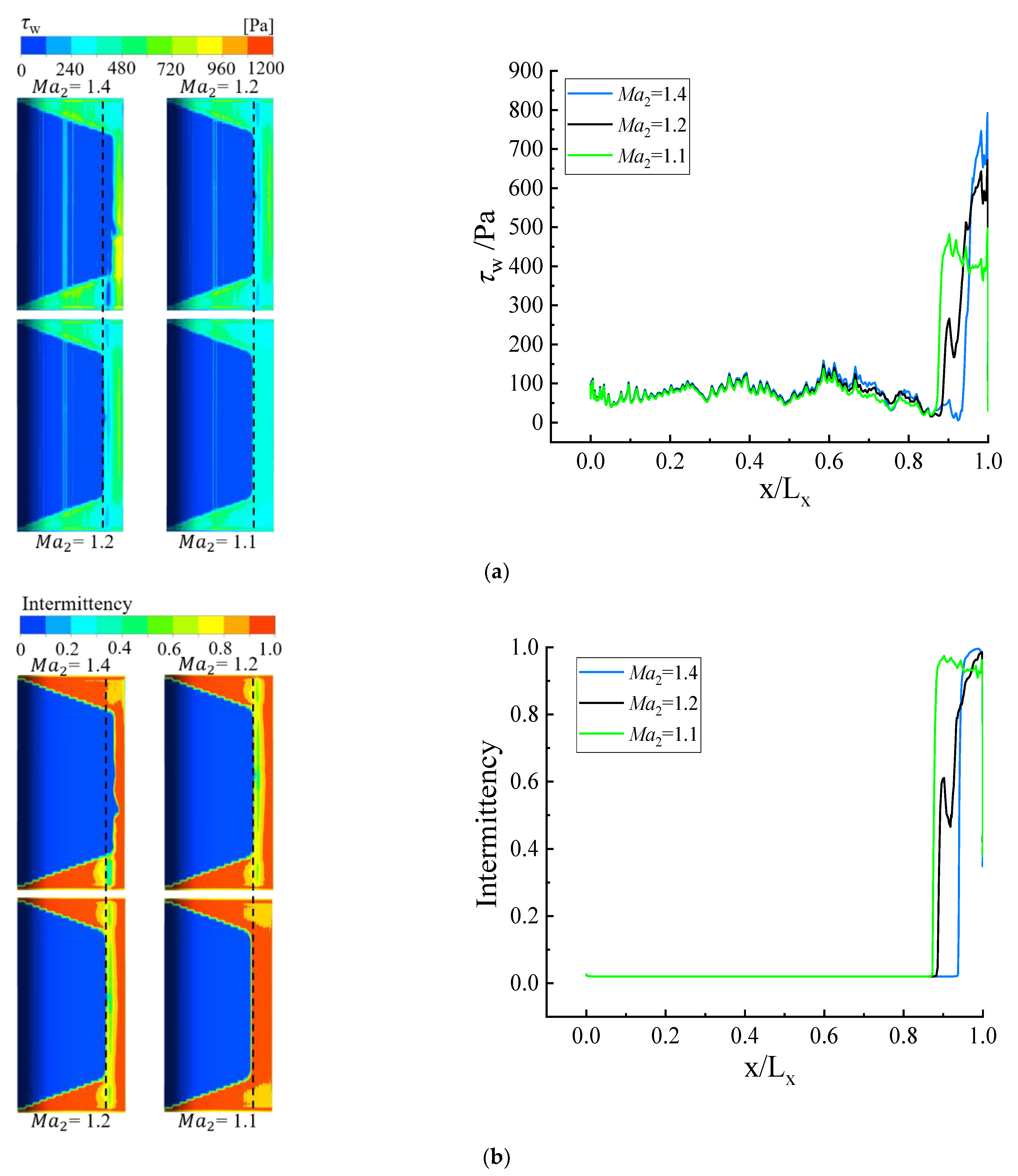
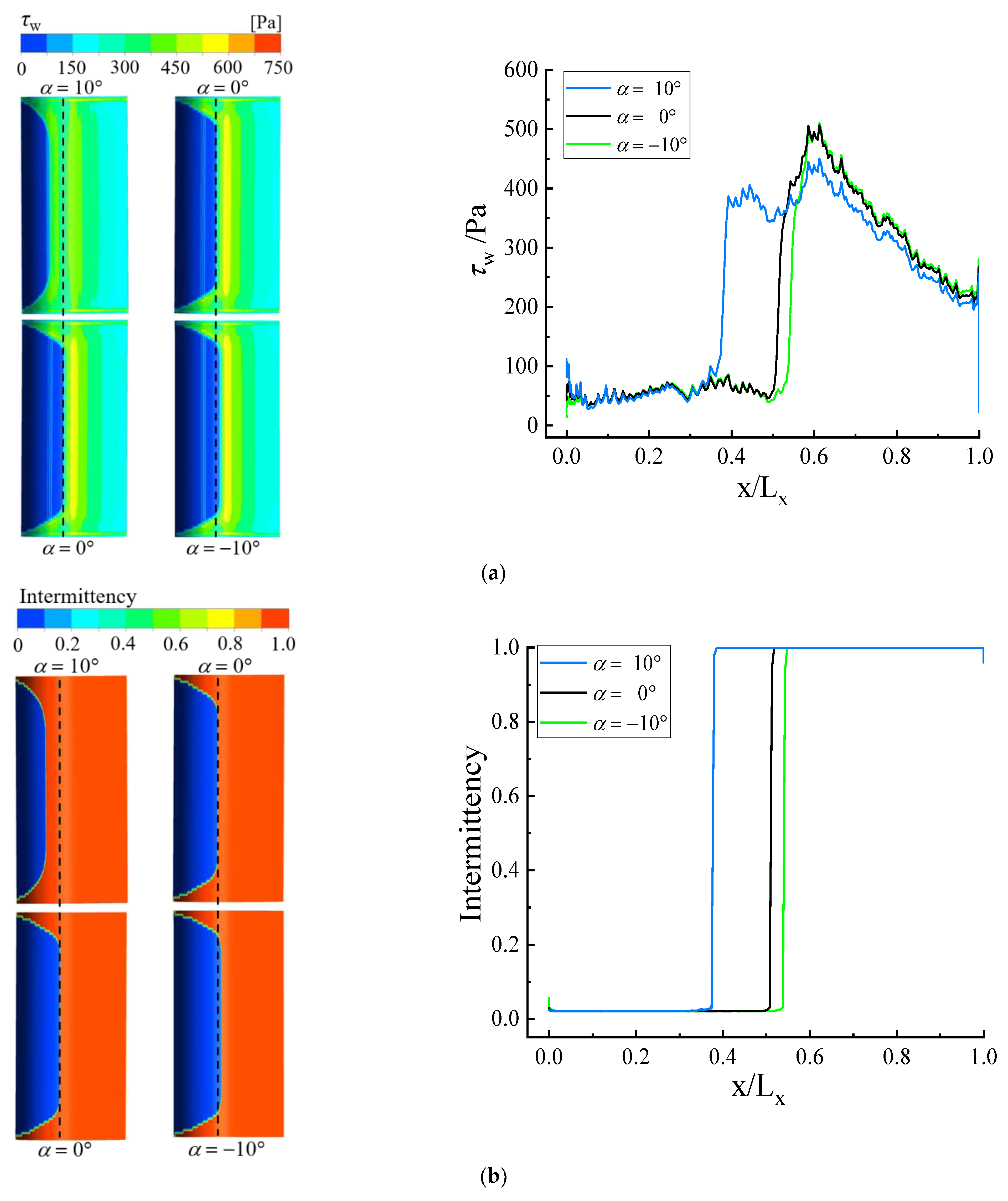
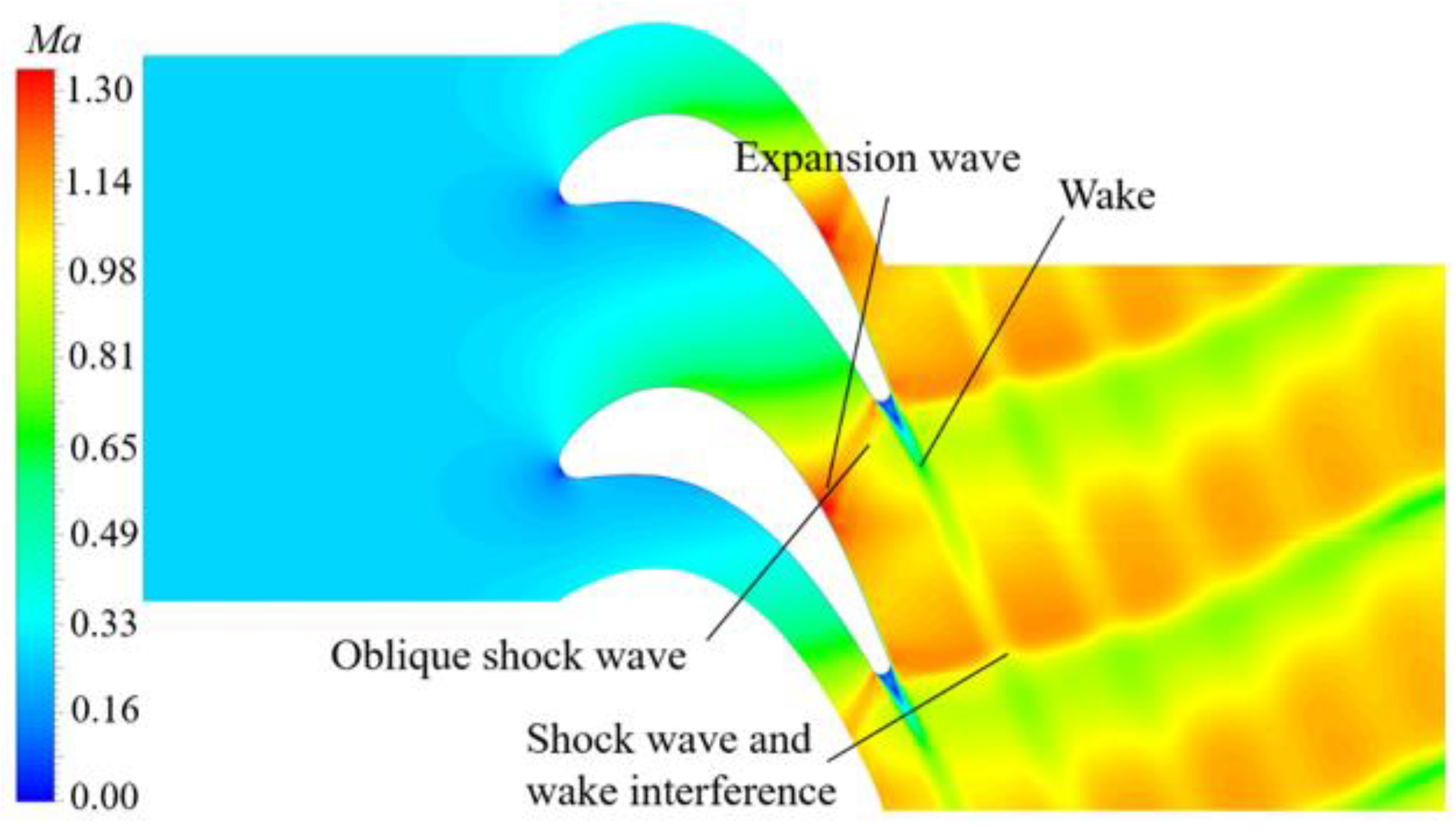
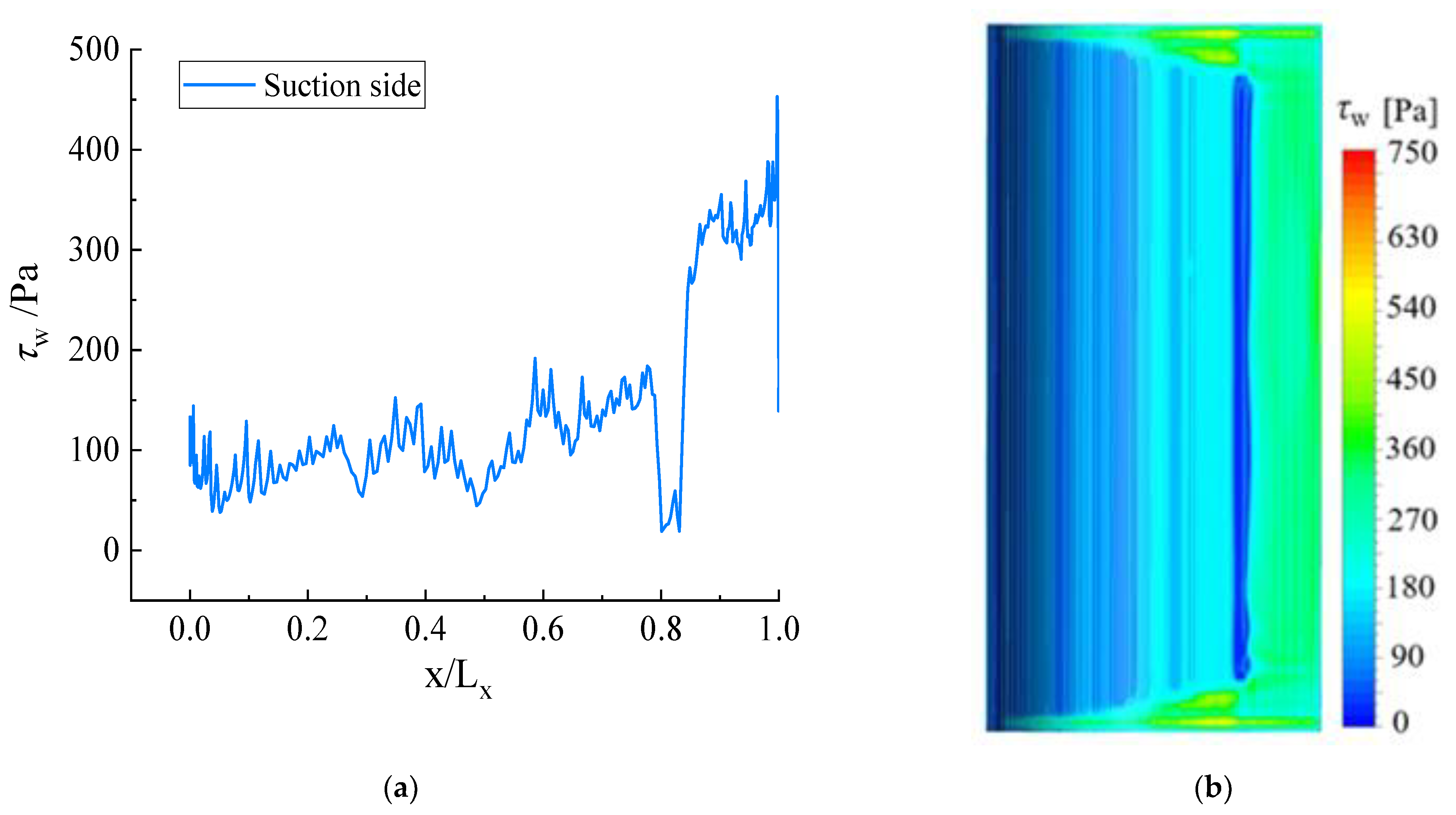

| Items | Value |
|---|---|
| Pressure sensitivity | 0.0%/kPa |
| Pressure range | 1 kPa~10 MPa |
| Temperature sensitivity | 1.4%/°C |
| Temperature range | 10 °C to 80 °C |
| Response time | 750 ms |
| Excitation wavelength | 400 to 550 nm (peak, 470 nm) |
| Emission wavelength | 600 to 750 nm (peak, 620 nm) |
| Photodegradation rate | 1%/h |
| Expiration date | 12 months |
| Parameters | Value |
|---|---|
| Inlet flow angle (β) | 30° |
| Blade angle relative to cascade axis (θ) | 33.3° |
| Chord length (c) | 95 mm |
| Ratio of chord length to grating pitch (σ) | 1.40845 |
| Aspect ratio (h/c) | 2.0 |
| Number of blades in the cascade (N) | 7 |
| Test | pt1 | ps1 | Ma2 | Re1 | TIin |
|---|---|---|---|---|---|
| 1 | 172 kPa | 86.7 kPa | 1.03 | 8.6 × 105 | 0.3% |
| 2 | 170 kPa | 72.1 kPa | 1.2 | 8.6 × 105 | 0.3% |
| 3 | 59.1 kPa | 53.1 kPa | 0.4 | 3.1 × 105 | 0.3% |
| 4 | 103 kPa | 51.1 kPa | 1.03 | 5.1 × 105 | 0.3% |
| Item | Setting |
|---|---|
| Inlet boundary condition | Total pressure |
| Inlet total temperature | 300 K |
| Inlet turbulence intensity | 1% |
| Outlet boundary condition | Static pressure |
| Blade wall condition | No-slip wall |
| Upper and lower surfaces | No-slip wall |
| Advection scheme | High-resolution |
| Turbulence numeric | High-resolution |
| Residual convergence criterion | 1 × 10−5 |
Publisher’s Note: MDPI stays neutral with regard to jurisdictional claims in published maps and institutional affiliations. |
© 2022 by the authors. Licensee MDPI, Basel, Switzerland. This article is an open access article distributed under the terms and conditions of the Creative Commons Attribution (CC BY) license (https://creativecommons.org/licenses/by/4.0/).
Share and Cite
Ke, W.; Wang, H.; Zhang, W.; Huang, K.; Zhu, B. Boundary Layer Transition Prediction on Planar Turbine Cascade Using Temperature-Sensitive Paint and Numerical Simulation. Processes 2022, 10, 2078. https://doi.org/10.3390/pr10102078
Ke W, Wang H, Zhang W, Huang K, Zhu B. Boundary Layer Transition Prediction on Planar Turbine Cascade Using Temperature-Sensitive Paint and Numerical Simulation. Processes. 2022; 10(10):2078. https://doi.org/10.3390/pr10102078
Chicago/Turabian StyleKe, Wenliang, Hongbiao Wang, Wenwu Zhang, Kang Huang, and Baoshan Zhu. 2022. "Boundary Layer Transition Prediction on Planar Turbine Cascade Using Temperature-Sensitive Paint and Numerical Simulation" Processes 10, no. 10: 2078. https://doi.org/10.3390/pr10102078
APA StyleKe, W., Wang, H., Zhang, W., Huang, K., & Zhu, B. (2022). Boundary Layer Transition Prediction on Planar Turbine Cascade Using Temperature-Sensitive Paint and Numerical Simulation. Processes, 10(10), 2078. https://doi.org/10.3390/pr10102078







